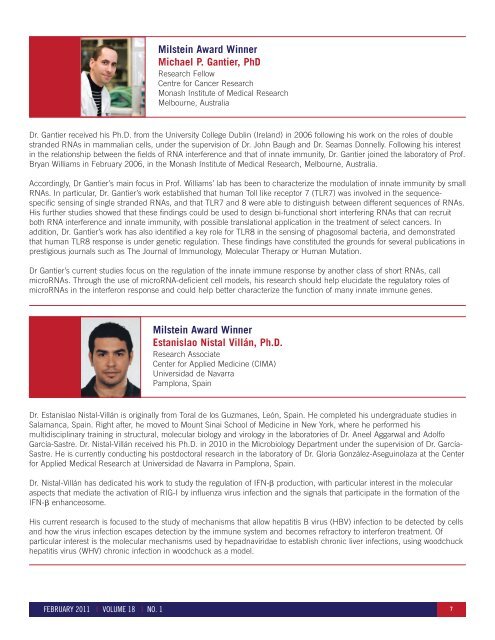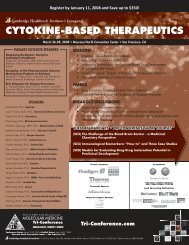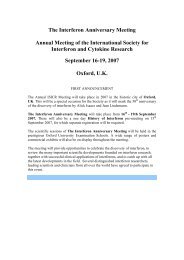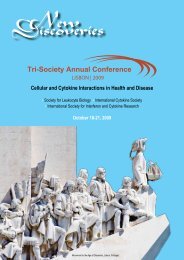9th Joint Meeting ISICR-ICS Cytokines & Interferons: From the ...
9th Joint Meeting ISICR-ICS Cytokines & Interferons: From the ...
9th Joint Meeting ISICR-ICS Cytokines & Interferons: From the ...
Create successful ePaper yourself
Turn your PDF publications into a flip-book with our unique Google optimized e-Paper software.
Milstein Award Winner<br />
Michael P. Gantier, PhD<br />
Research Fellow<br />
Centre for Cancer Research<br />
Monash Institute of Medical Research<br />
Melbourne, Australia<br />
Dr. Gantier received his Ph.D. from <strong>the</strong> University College Dublin (Ireland) in 2006 following his work on <strong>the</strong> roles of double<br />
stranded RNAs in mammalian cells, under <strong>the</strong> supervision of Dr. John Baugh and Dr. Seamas Donnelly. Following his interest<br />
in <strong>the</strong> relationship between <strong>the</strong> fields of RNA interference and that of innate immunity, Dr. Gantier joined <strong>the</strong> laboratory of Prof.<br />
Bryan Williams in February 2006, in <strong>the</strong> Monash Institute of Medical Research, Melbourne, Australia.<br />
Accordingly, Dr Gantier’s main focus in Prof. Williams’ lab has been to characterize <strong>the</strong> modulation of innate immunity by small<br />
RNAs. In particular, Dr. Gantier’s work established that human Toll like receptor 7 (TLR7) was involved in <strong>the</strong> sequencespecific<br />
sensing of single stranded RNAs, and that TLR7 and 8 were able to distinguish between different sequences of RNAs.<br />
His fur<strong>the</strong>r studies showed that <strong>the</strong>se findings could be used to design bi-functional short interfering RNAs that can recruit<br />
both RNA interference and innate immunity, with possible translational application in <strong>the</strong> treatment of select cancers. In<br />
addition, Dr. Gantier’s work has also identified a key role for TLR8 in <strong>the</strong> sensing of phagosomal bacteria, and demonstrated<br />
that human TLR8 response is under genetic regulation. These findings have constituted <strong>the</strong> grounds for several publications in<br />
prestigious journals such as The Journal of Immunology, Molecular Therapy or Human Mutation.<br />
Dr Gantier’s current studies focus on <strong>the</strong> regulation of <strong>the</strong> innate immune response by ano<strong>the</strong>r class of short RNAs, call<br />
microRNAs. Through <strong>the</strong> use of microRNA-deficient cell models, his research should help elucidate <strong>the</strong> regulatory roles of<br />
microRNAs in <strong>the</strong> interferon response and could help better characterize <strong>the</strong> function of many innate immune genes.<br />
Milstein Award Winner<br />
Estanislao Nistal Villán, Ph.D.<br />
Research Associate<br />
Center for Applied Medicine (CIMA)<br />
Universidad de Navarra<br />
Pamplona, Spain<br />
Dr. Estanislao Nistal-Villán is originally from Toral de los Guzmanes, León, Spain. He completed his undergraduate studies in<br />
Salamanca, Spain. Right after, he moved to Mount Sinai School of Medicine in New York, where he performed his<br />
multidisciplinary training in structural, molecular biology and virology in <strong>the</strong> laboratories of Dr. Aneel Aggarwal and Adolfo<br />
García-Sastre. Dr. Nistal-Villán received his Ph.D. in 2010 in <strong>the</strong> Microbiology Department under <strong>the</strong> supervision of Dr. García-<br />
Sastre. He is currently conducting his postdoctoral research in <strong>the</strong> laboratory of Dr. Gloria González-Aseguinolaza at <strong>the</strong> Center<br />
for Applied Medical Research at Universidad de Navarra in Pamplona, Spain.<br />
Dr. Nistal-Villán has dedicated his work to study <strong>the</strong> regulation of IFN- production, with particular interest in <strong>the</strong> molecular<br />
aspects that mediate <strong>the</strong> activation of RIG-I by influenza virus infection and <strong>the</strong> signals that participate in <strong>the</strong> formation of <strong>the</strong><br />
IFN- enhanceosome.<br />
His current research is focused to <strong>the</strong> study of mechanisms that allow hepatitis B virus (HBV) infection to be detected by cells<br />
and how <strong>the</strong> virus infection escapes detection by <strong>the</strong> immune system and becomes refractory to interferon treatment. Of<br />
particular interest is <strong>the</strong> molecular mechanisms used by hepadnaviridae to establish chronic liver infections, using woodchuck<br />
hepatitis virus (WHV) chronic infection in woodchuck as a model.<br />
FEBRUARY 2011 I VOLUME 18 I NO. 1 7







